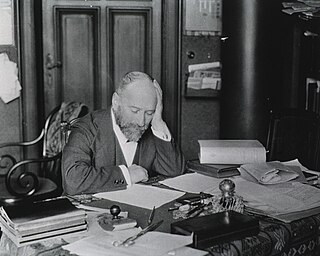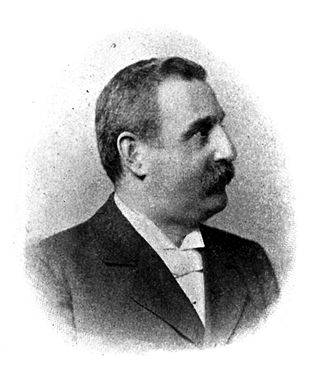
Theodor Escherich was a German-Austrian pediatrician and a professor at universities in Graz and Vienna. He discovered and described the bacterium Escherichia coli.

Rudolf Friedrich Johann Heinrich Wagner was a German anatomist and physiologist and the co-discoverer of the germinal vesicle. He made important investigations on ganglia, nerve-endings, and the sympathetic nerves.

The Gottfried Wilhelm Leibniz Prize, or Leibniz Prize, is awarded by the German Research Foundation to "exceptional scientists and academics for their outstanding achievements in the field of research". Since 1986, up to ten prizes have been awarded annually to individuals or research groups working at a research institution in Germany or at a German research institution abroad. It is considered the most important research award in Germany.

Jacob Moleschott was a Dutch physiologist and writer on dietetics. He is known for his philosophical views in regard to scientific materialism. He was a member of German Academy of Sciences Leopoldina.

Nathan Zuntz was a German physiologist born in Bonn. He was a pioneer of modern altitude physiology and aviation medicine.

Methamphetamine is a potent central nervous system (CNS) stimulant that is mainly used as a recreational drug and less commonly as a second-line treatment for attention deficit hyperactivity disorder and obesity. Methamphetamine was discovered in 1893 and exists as two enantiomers: levo-methamphetamine and dextro-methamphetamine. Methamphetamine properly refers to a specific chemical substance, the racemic free base, which is an equal mixture of levomethamphetamine and dextromethamphetamine in their pure amine forms, but the hydrochloride salt, commonly called crystal meth, is widely used. Methamphetamine is rarely prescribed over concerns involving human neurotoxicity and potential for recreational use as an aphrodisiac and euphoriant, among other concerns, as well as the availability of safer substitute drugs with comparable treatment efficacy such as Adderall and Vyvanse. Dextromethamphetamine is a stronger CNS stimulant than levomethamphetamine.

Walther Spielmeyer was a German neuropathologist who was a native of Dessau.

Rudolf Otto Anselm Höber was a German physician and physiologist who was forced to emigrate from Nazi Germany.
Akira Ogata was a Japanese chemist and the first to synthesize methamphetamine in crystalline form in 1919.

The generally tolerant official drug policy in the Third Reich, the period of Nazi control of Germany from the 1933 Machtergreifung to Germany's 1945 defeat in World War II, was inherited from the Weimar government which was installed in 1919 following the dissolution of the German monarchy at the end of World War I.
Amphetamine and methamphetamine are central nervous system stimulants used to treat a variety of conditions. When used recreationally, they are colloquially known as "speed" or sometimes "crank". Amphetamine was first synthesized in 1887 in Germany by Romanian chemist Lazăr Edeleanu, who named it phenylisopropylamine. Around the same time, Japanese organic chemist Nagai Nagayoshi isolated ephedrine from the Chinese ephedra plant and later developed a method for ephedrine synthesis. Methamphetamine was synthesized from ephedrine in 1893 by Nagayoshi. Neither drug had a pharmacological use until 1934, when Smith, Kline & French began selling amphetamine as an inhaler under the trade name Benzedrine for congestion.

Willibald Nagel was a German physiologist, best known for his work in the field of sensory physiology.

Immanuel Munk was a German physiologist. He was the younger brother of physiologist Hermann Munk (1839–1912).
Karl Ernst Ranke was a German internist, pediatrician and pulmonologist known for his research of tuberculosis. He was the son of anthropologist Johannes Ranke (1836–1916).

Heinrich von Ranke was a German physiologist and pediatrician. He was the son of theologian Friedrich Heinrich Ranke (1798-1876) and the brother of anthropologist Johannes Ranke (1836-1916). Famed historian Leopold von Ranke (1795-1886) was his uncle.

Johannes Ranke was a German physiologist and anthropologist. He was the son of theologian Friedrich Heinrich Ranke (1798–1876), the brother of pediatrician Heinrich von Ranke (1830–1909) and father to pulmonologist Karl Ernst Ranke (1870–1926).
Albrecht Julius Theodor Bethe was a German physiologist. He was the father of physicist Hans Bethe (1906–2005).
Stimulant use disorder is a type of substance use disorder where the use of stimulants caused clinically significant impairment or distress. It is defined in the DSM-5 as "the continued use of amphetamine-type substances, cocaine, or other stimulants leading to clinically significant impairment or distress, from mild to severe". These psychoactive drugs, known as stimulants, are among the most widely used drugs in the world today, although not all stimulants can induce addiction. As of 1993, Approximately 200 million Americans have used some type of stimulant in the past year alone.
Amphetamine type stimulants (ATS) are a group of synthetic drugs that are chemical derivatives of the parent compound alpha-methylphenethylamine, also known as amphetamine. Common ATS includes amphetamine, methamphetamine, ephedrine, pseudoephedrine, 3,4-methylenedioxymethamphetamine (MDMA), 3,4-methylenedioxyamphetamine (MDA) and 3,4-methylenedioxyethylamphetamine (MDEA). ATS when used illicitly has street names including ice, meth, crystal, crank, bennies, and speed. Within the group of amphetamine-type stimulants, there are also prescription drugs including mixed amphetamine salts, dextroamphetamine, and lisdexamfetamine.













